The PHW office will close at 3 PM on Thursday, April 17th, and reopen on Monday, April 24th. The 50th Anniversary posts will be on hiatus this Friday and resume on April 25th.
Have a happy and safe Easter weekend!

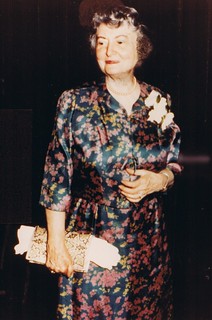 In 1978, PHW received its largest gift to date: the home of early founding member Lucille Lozier. “The Duchess,” who famously led PHW during the final year of the fight to save the Conrad House and laid the groundwork for the Historic District and Board of Architectural Review, bequeathed her home at 211 S. Washington St., some of her antiques, and a nucleus of funds to preserve and maintain the grounds to PHW.(1)(2)
In 1978, PHW received its largest gift to date: the home of early founding member Lucille Lozier. “The Duchess,” who famously led PHW during the final year of the fight to save the Conrad House and laid the groundwork for the Historic District and Board of Architectural Review, bequeathed her home at 211 S. Washington St., some of her antiques, and a nucleus of funds to preserve and maintain the grounds to PHW.(1)(2)
After discussion, the PHW board voted to accept the house and conduct feasibility studies to determine the best use of the house in accordance to the spirit of her will. The major consideration was to make the house self-sustaining, so that PHW could continue its work preserving other property with the Jennings Revolving Fund. The committee, consisting of Judy Juergans, Chuck Yerkes, Katie Rockwood, Lee Taylor, Jim Laidlaw, Eleanor White, and Betsy Helm were charged with this task.
In May, the committee returned with their findings. The house was in need of maintenance, so it was suggested some of the Lozier fund be put toward the repairs to the most pressing issues concerning the roof rafters and basement walls, and a decorator showcase could be held in the house as a fundraiser. However, the necessary structural work complicated the fundraising plan, and it appears the decorator showcase had to be cancelled.
 Subsequently, the house was prepared for a single family residence rental property. It was anticipated that PHW would move its office into the Lozier House at a later point. However, the maintenance issues cost more and took longer to repair than anticipated. The house was not rented until 1980; this happily coincided with a lull in the Revolving Fund activity, which allowed PHW to operate as a landlord for a few years and to make incremental improvements to the property. By 1983, with the house substantially repaired, the grounds cleaned of dead trees and wild shrubbery, the Lozier maintenance fund depleted, and a number of significant properties becoming threatened in the downtown, the PHW board felt the pressure to get back into the Revolving Fund full time and end the landlord experiment. The Lozier House was sold to the tenants in 1983 with covenants similar to those placed on the Revolving Fund properties.
Subsequently, the house was prepared for a single family residence rental property. It was anticipated that PHW would move its office into the Lozier House at a later point. However, the maintenance issues cost more and took longer to repair than anticipated. The house was not rented until 1980; this happily coincided with a lull in the Revolving Fund activity, which allowed PHW to operate as a landlord for a few years and to make incremental improvements to the property. By 1983, with the house substantially repaired, the grounds cleaned of dead trees and wild shrubbery, the Lozier maintenance fund depleted, and a number of significant properties becoming threatened in the downtown, the PHW board felt the pressure to get back into the Revolving Fund full time and end the landlord experiment. The Lozier House was sold to the tenants in 1983 with covenants similar to those placed on the Revolving Fund properties.
Although PHW never utilized the Lozier House as office or special event space as Lucille Lozier envisioned, PHW members who knew her thought she would not wish the house to become a burden on the organization and would see the pragmatism in selling the house to others who could continue to care and treasure it. Proceeds from the sale were set aside as a nest egg to fund office staff salary and other Revolving Fund activities.

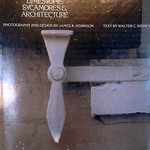 PHW dipped its toe in publishing with a coffee table style book showcasing Winchester’s architecture with professional photographs by James R. Morrison and text by architectural historian Walter Kidney. (1)(2) Riding the crest of the survey work and educational efforts, “Limestone, Sycamores and Architecture” was in some ways the culmination of all the various documentation and educational efforts up to that point, condensed into a visually appealing black and white photographic essay.
PHW dipped its toe in publishing with a coffee table style book showcasing Winchester’s architecture with professional photographs by James R. Morrison and text by architectural historian Walter Kidney. (1)(2) Riding the crest of the survey work and educational efforts, “Limestone, Sycamores and Architecture” was in some ways the culmination of all the various documentation and educational efforts up to that point, condensed into a visually appealing black and white photographic essay.
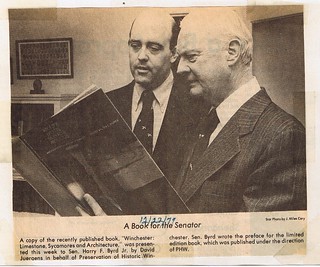 Instead of focusing on the stories of individual buildings like Quarles’ books on historic properties, “Limestone, Sycamores and Architecture” attempted to provide an overview of the growth and changes of the town as a whole in five epochs – 1732-1770, 1770-1820, 1820-1865, 1865-1890, and 1890-present – using select images to illustrate the historic architecture of each era.
Instead of focusing on the stories of individual buildings like Quarles’ books on historic properties, “Limestone, Sycamores and Architecture” attempted to provide an overview of the growth and changes of the town as a whole in five epochs – 1732-1770, 1770-1820, 1820-1865, 1865-1890, and 1890-present – using select images to illustrate the historic architecture of each era.
The book, with its timeless images captured in black and white, was dedicated to Lucille Lozier, president of PHW during the final fight for the Conrad House. Preorders were taken in 1976 to determine the print run, and in December of 1977, the first books were in-hand.(3) Three thousand books were printed. The first copy was presented to Mrs. Lozier at her home in a small commemorative ceremony. Seeing the book in-hand after three years of preparation was a “long-cherished dream [that] became reality.” (4)
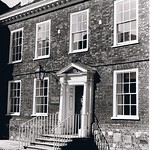 The PHW elves have been busy scanning images from our collection. Can you recognize these Winchester landmarks? View the set on Flickr.
The PHW elves have been busy scanning images from our collection. Can you recognize these Winchester landmarks? View the set on Flickr.
Thanks for your patience while the March 25 video was receiving some tweaks. The map handout using the O.W. Gray map and several iterations of the Winchester Sanborn maps have been incorporated into the slideshow to help you hone in on the neighborhood of each site being discussed. Audience questions were unfortunately not picked up well in the recording and were not included. Also, Sandra would like to apologize to Bo’s Belly Barn for calling their establishment a Sheetz. The original gas station that replaced the Hollis House was, however, an Atlantic station as can be seen in the photo.
Because we are interested in history and know you are, too, the relevant texts consulted for each property are listed below so you can read more about them.
Winchester Inn: “John Handley and the Handley Bequests to Winchester, Virginia” by Garland Quarles, pp. 40-51. (The Fauntleroy property on the O.W. Gray Map is “Aspen Hill.”)
Judge Richard Parker: “Shenandoah Valley Pioneers and Their Descendants” by T.K. Cartmell, p. 299.
Angerona: “Shenandoah Valley Pioneers and Their Descendants” by T.K. Cartmell, pp. 151, 158-159.
Cannon Ball House: “What I Know About Winchester” by William Greenway Russell, p. 63 footnote 38.
Graichen Glove Factory: “Shenandoah Valley Pioneers and Their Descendants” by T.K. Cartmell, pp. 149.
Hart Hotel:”What I Know About Winchester” by William Greenway Russell, p. 94
Empire Theatre: cinematreasures.org/theaters/22758
C.B Henry Store: “What I Know About Winchester” by William Greenway Russell, p. 59 footnote 6.
Barton House: “What I Know About Winchester” by William Greenway Russell, p. 114 footnote 17.
Former Masonic Lodge: www.winchesterhiram21.org/history.htm
Kent St. Presbyterian Church: “Shenandoah Valley Pioneers and Their Descendants” by T.K. Cartmell, pp. 175-176.
Piccadilly Apartments: “What I Know About Winchester” by William Greenway Russell, p. 141 footnote 39.
Bettie Dandrige House: “Shenandoah Valley Pioneers and Their Descendants” by T.K. Cartmell, p. 81; www.firstladies.org
Hollis House: “What I Know About Winchester” by William Greenway Russell, p. 123, 137 footnote 8.
Chanticleer Inn: “What I Know About Winchester” by William Greenway Russell, p. 29 footnote 32.
Dr. Baldwin Office: “What I Know About Winchester” by William Greenway Russell, p. 49-50, 60 footnote 13. For more on the boot legend, see “Virginia Baron: The Story of Thomas 6th Lord Fairfax” by Stuart E. Brown, Jr.
Capper House: “What I Know About Winchester” by William Greenway Russell, p. 80 footnote 50.
Faulkner Block: “Shenandoah Valley Pioneers and Their Descendants” by T.K. Cartmell, p. 496
St. Stephens CME Church: www.handleyregional.org/
W.B. Baker House: “What I Know About Winchester” by William Greenway Russell, p. 96, 113 footnote 12.
17 N. Braddock and Phil O’Rear Cottage: Unpublished PHW member research.
Mary Greenhow Lee House: www.shenandoahatwar.org/The-History/The-People/Mary-Greenhow-Lee
Conrad House: A comprehensive overview of the Conrad House and PHW’s involvement can be found in this blog on Jan. 10, Jan. 17, Jan. 24, and Jan. 31
Scott Affleck House: “Shenandoah Valley Pioneers and Their Descendants” by T.K. Cartmell, p. 460. The house was built from design No. 18 by architect George F. Barber.
Keckley Mill: “Shenandoah Valley Pioneers and Their Descendants” by T.K. Cartmell, p. 69
Hardee’s: “Prototype of ’60’s May Disappear,” The Winchester Star, Sept. 10, 1988.
 Along with the increased activity of PHW in the 1970s came the need for a formal office space to better conduct the business of the organization. The first temporary office was set up in the south wing of “Fair Mount” on Fairmont Avenue, but already the volunteers were on the lookout for a space to call PHW Headquarters. The search led back to 8 East Cork Street, the small stone building PHW had hoped to purchase a few years earlier.
Along with the increased activity of PHW in the 1970s came the need for a formal office space to better conduct the business of the organization. The first temporary office was set up in the south wing of “Fair Mount” on Fairmont Avenue, but already the volunteers were on the lookout for a space to call PHW Headquarters. The search led back to 8 East Cork Street, the small stone building PHW had hoped to purchase a few years earlier.
Now owned by the First Presbyterian Church, the former Friendship Market was looking sadly dilapidated and abandoned. PHW members volunteered to spruce up the interior and exterior of the building for more hands-on preservation work for their future office. An anonymous donor underwrote the expenses of new wiring, insulation, window sashes, doors, ceilings, and leveling the floors. The faux-stone facade was removed from the eastern frame addition, paint was removed from the limestone, the roof was replaced, missing windows were restored, and much of the rear wall was painstaking rebuilt with matching limestone from John Rodman’s farm. Sarah Pugh donated her landscaping skills to complete the exterior overhaul.
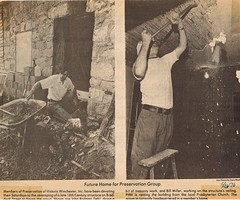 John Rodman and Bill Miller did most of the work, going on-site every Saturday for close to a year preparing the building for its new use. PHW announced its upcoming move to 8 East Cork Street in February 1977, expecting to move in the next month.
John Rodman and Bill Miller did most of the work, going on-site every Saturday for close to a year preparing the building for its new use. PHW announced its upcoming move to 8 East Cork Street in February 1977, expecting to move in the next month.
Moving day was set for mid-March. Images in the Winchester Star captured PHW volunteers Tom Rockwood and Jay Wetzel moving in the antique furniture to complete the workspace. Just a week later, the PHW Board of Directors held their first meeting in the building, making the building officially seem like home. After a bit of settling in, an open house was held in June of that year. People were encouraged to stop by and take advantage of PHW’s increased visibility in the downtown office. As stated in the March 15, 1977 Winchester Star article, “8 East Cork Street is there for the benefit and enjoyment of all.” (1) The building was to be PHW’s home for the next eight years.

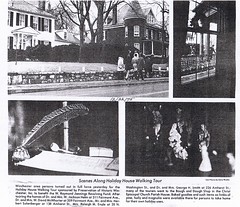 Although PHW has secured lines of credit and several grants and loans through the National Trust as part of the Jennings Revolving Fund and Simon Lauck House project, there was always a need to replenish the coffers with fundraisers. Thus the Holiday House Tour was born in 1975.
Although PHW has secured lines of credit and several grants and loans through the National Trust as part of the Jennings Revolving Fund and Simon Lauck House project, there was always a need to replenish the coffers with fundraisers. Thus the Holiday House Tour was born in 1975.
The tour took its cues from similar events in Charleston and Savannah. Grand homes would be traditionally decorated and opened to visitors via guided tours, with the proceeds from the ticket sales benefiting the local revolving fund. The first tour, fittingly enough, focused on the homes of PHW members along Fairmont Avenue, Amherst Street, and North Washington Street with a rest stop with hot drinks at Christ Episcopal Church. The Bough and Dough Shop was also held at the church.(1)(2)
 The formula proved successful, and the tour has been followed that pattern since then with only two noteworthy experiments in approach. The first, in 1978, was an “exterior only” tour of other in-progress Revolving Fund Houses on South Loudoun Street, with Lee Taylor donating an enormous gingerbread castle for a raffle. Although still a successful fundraiser, the event was quickly refocused on providing interior tours. The second change occurred in 1989, when Saturday tour hours were added for the first time, likely to help ease the difficulty of visiting the sites as the tour focused on county properties that year (not a “walkable” tour as is generally the norm). Since then, the Saturday hours morphed into the Preview Party on Saturday evening.
The formula proved successful, and the tour has been followed that pattern since then with only two noteworthy experiments in approach. The first, in 1978, was an “exterior only” tour of other in-progress Revolving Fund Houses on South Loudoun Street, with Lee Taylor donating an enormous gingerbread castle for a raffle. Although still a successful fundraiser, the event was quickly refocused on providing interior tours. The second change occurred in 1989, when Saturday tour hours were added for the first time, likely to help ease the difficulty of visiting the sites as the tour focused on county properties that year (not a “walkable” tour as is generally the norm). Since then, the Saturday hours morphed into the Preview Party on Saturday evening.
The tour, in addition to being a fundraiser, was also conceived by the organizers as a way to involve all of the members of PHW in an event. Although it is unlikely we have ever reached the goal of “100% participation” from our members, the tour regularly involves at least one-third of the membership in some capacity, whether as a homeowner, decorator, docent, musician, craftsman, baker, or ticket taker. Not too shabby.
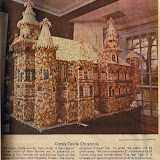 |
| Holiday House Tours |
Images from some early Holiday House Tours have been scanned, with more waiting to be digitized. Take a trip down memory lane at the Picasa album.
Sandra Bosley, Executive Assistant for Preservation of Historic Winchester, presents the next Lunch and Learn lecture on “Vanished Winchester, the Lost Architecture that Inspired the Creation of PHW and the Historic District.”
Date: March 25, 2014
Time: Noon-1 p.m.
Location: June Jeffries Educational Center at the upper parking lot of the Lewis-Jones Knitting Mill, 126 N. Kent Street, Winchester, VA
RSVP: Appreciated but not required
Cost: Free, unless you reserve a boxed lunch through PHW
Lunch: Bring your own lunch or pre-order a Panera boxed lunch by 5 p.m. on March 24
Questions? Contact PHW at phwi@verizon.net or 540-667-3577.
Lunch signups are now closed. Thank you!
 PHW became serious about documenting the town in 1974. As we saw in the Simon Lauck house post, the 1966 survey of worthy buildings was what you would call a “windshield survey,” or the kind of quick visual determination a researcher would make based just on what could be observed from a site visit.(1) (2) The term windshield survey is derived from the typical practice of driving through neighborhoods and looking at the buildings through the windshield to form an overview of the area and its character. Obviously any information gathered from this work is preliminary, and Winchester’s 1966 survey was no exception. It contained no history, no attempt at dating structures, nor even any attempt at recording the architectural style of the building in question.
PHW became serious about documenting the town in 1974. As we saw in the Simon Lauck house post, the 1966 survey of worthy buildings was what you would call a “windshield survey,” or the kind of quick visual determination a researcher would make based just on what could be observed from a site visit.(1) (2) The term windshield survey is derived from the typical practice of driving through neighborhoods and looking at the buildings through the windshield to form an overview of the area and its character. Obviously any information gathered from this work is preliminary, and Winchester’s 1966 survey was no exception. It contained no history, no attempt at dating structures, nor even any attempt at recording the architectural style of the building in question.
Omission from the 1966 list was part of what made the fight to save the Simon Lauck house so difficult to justify to the regional Salvation Army – without documentation, it is easy to dismiss sad-looking houses as expendable and historically worthless, particularly if the historic significance is of local interest or hinges upon unique architectural features. Although today we generally talk about the financial incentives behind a National Register listing, the broader goal is to raise awareness of the historic resources we should preserve in our own backyards.(3)(4) That was the primary motivation for the 1976 survey, as well as providing PHW direction for areas to work on for the Revolving Fund and a tool to aid the Board of Architectural Review with applications.
First, a class of UVA graduate students – Julia Henley, Samuel Klingensmith, Nancy Recchie, and Royce Yeater – completed survey work for approximately 300 buildings. They focused on the northwestern portion of the current historic district. A small group of PHW volunteers took up the remainder of the 1060 properties where the student researchers stopped. Katie Rockwood coordinated the group, consisting of field workers Pat Zontine, Joanna Berg, Sandy Lee, Virginia Miller and photographer Ben Ritter. John G. Lewis reviewed the forms and corrected information as the architectural historian. The survey took two years to complete, and was acknowledged as often being a “best guess” based on the exterior details and historical information available at the time of the survey. The Sanborn Fire Insurance maps of 1897 were used extensively in the research, with volunteers color-coding the maps by construction materials.
The survey forms included basic information such as the address, present owner, historic name and/or original owner where available, construction date estimated by decade, architectural style based on exterior visual clues, and a sliding scale of architectural significance from “excellent” to “none.” The “none” category included modern construction and on occasion older buildings that had been inappropriately altered, often with notes on what alterations could be made to improve the appearance. Many, but not all, properties included a written architectural description to supplement the photographs, which can be used in situations like the Noakes House project, when a cornice needed to be recreated but no good visual image of the cornice was available. The written description could give some indication of what it “should” have looked like. In some cases, deed research or historical descriptions were also included to back up construction dates or original owners.
Although now superseded by the 2008-2011 survey, the work from the 1976 survey continues to be used in BAR applications today due to its easy to read “at a glance” format and now historic photographic documentation.
 |
| 1976 Architectural Survey |
 At last, with a trained revolving fund director and a recharged membership united behind the memory of Ray Jennings, PHW was ready to tackle a project through the Revolving Fund. That property just happened to be the Simon Lauck House at 311 South Loudoun Street. In 1974, the Salvation Army had purchased the duplex at 309-311 South Loudoun Street with an eye toward demolishing the building to expand the operations in their headquarters at 303 South Loudoun Street. PHW was interested in preserving the otherwise unassuming-looking building, because preserved inside the duplex was the log cabin of a famous early owner, Simon Lauck.
At last, with a trained revolving fund director and a recharged membership united behind the memory of Ray Jennings, PHW was ready to tackle a project through the Revolving Fund. That property just happened to be the Simon Lauck House at 311 South Loudoun Street. In 1974, the Salvation Army had purchased the duplex at 309-311 South Loudoun Street with an eye toward demolishing the building to expand the operations in their headquarters at 303 South Loudoun Street. PHW was interested in preserving the otherwise unassuming-looking building, because preserved inside the duplex was the log cabin of a famous early owner, Simon Lauck.
The duplex had not originally been listed in PHW’s 1966 list of worthy buildings in part because the Victorian-era makeover had been too complete, making the house look “younger” than it actually was. The initial survey of Winchester had lacked many of the tools we now take for granted when researching area buildings, like Sanborn Fire Insurance Maps. However, more intensive research uncovered the core of the building was much older and more important than anyone first guessed.
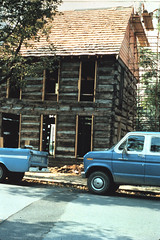 Simon Lauck, along with his brothers Peter (of Red Lion Tavern fame) and Abraham, was part of the Dutch Mess organized in Winchester during the Revolutionary War. According to local legend, the Lauck brothers were part of Daniel Morgan’s honor guard and acted as translators with captured Hessians soldiers. After the Revolutionary War, the brothers returned to Winchester, each taking up residence on South Loudoun Street. Simon set up his gunsmithy on this property. Over the years, the house was expanded, then later updated with Victorian gingerbread details. By the 1970s, the Simon Lauck house was in decline, leading to its potential status as a playground.
Simon Lauck, along with his brothers Peter (of Red Lion Tavern fame) and Abraham, was part of the Dutch Mess organized in Winchester during the Revolutionary War. According to local legend, the Lauck brothers were part of Daniel Morgan’s honor guard and acted as translators with captured Hessians soldiers. After the Revolutionary War, the brothers returned to Winchester, each taking up residence on South Loudoun Street. Simon set up his gunsmithy on this property. Over the years, the house was expanded, then later updated with Victorian gingerbread details. By the 1970s, the Simon Lauck house was in decline, leading to its potential status as a playground.
When PHW approached the Salvation Army to purchase the Simon Lauck house, the initial offer was only for the logs after the house was demolished. This offer was not good enough for PHW, sparking a long and heated back-and-forth negotiation with regional Salvation Army leaders. In the end, the negotiations succeeded and PHW owned its very first historic building.
The plan at the time was to restore the building’s exterior to its appearance circa 1790 as a proof to Winchester that many of the “Victorian” houses in the Potato Hill area in fact contained a much older log nucleus. To achieve this, a substantial portion of the house was removed, reducing it from a duplex to a single residence and stripping most of the exterior away. PHW volunteers did a great deal of the hands-on work at the Simon Lauck house, as documented by Virginia Miller.
In 1976, the log cabin was exposed and a new owner purchased the building from PHW and completed the work in making the former duplex a charming office. Although the ride was bumpy, in the end one of Winchester’s oldest log buildings was preserved and still serves as a reminder of our frontier roots just blocks from Old Town.

 |
| View more progress pictures of the Simon Lauck House at Picasa |
For more reading on the Lauck family and gunsmithy, investigate some of the following links:
Lauck Family Genealogy
A Simon Lauck Buck and Ball Gun
A John Lauck Rifle at the Museum of the Shenandoah Valley